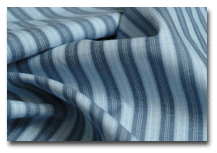T
he good news is: the Federal Reserve cut interest rates by half a percentage point, and
Chairman Alan Greenspan said the Fed would not hesitate to cut rates further if necessary. The bad
news is: don’t count on lower interest rates to do much for yarn manufacturing, which is still
struggling with building inventories and with overcapacity. As one spinner said, “The interest rate
cut is a non-event as far as our business is concerned.” Consumer spending is rapidly declining, as
the national unemployment rate has climbed to 5.7 percent. Skepticism is building now that
congressional approval is in place for a US invasion of Iraq.
The impact on yarn manufacturing seems to be affecting all sectors to some extent. The
president of a large spinning company said, “There seems to be a universal pause in business right
now … we are going to batten down the hatches and try to ride out the storm until mid-2003.”
Several firms are reporting stronger third-quarter earnings due to cost cutting, while indicating
declining sales across most of their businesses. Air-jet yarns were holding their own for a while;
however, even this sector is suffering now that the fleece season is over.
Spinners also are struggling with increases in raw material prices. The potential threat in
Iraq has driven the price of crude oil to $25 a barrel. Fiber producers are trying to pass the
increases in petrochemicals on to the spinners.
Cotton prices are up substantially. The US Department of Agriculture (USDA) reports storm
losses in the Delta and Southeast may dramatically affect quality and yield. As one spinner pointed
out, “Good-quality cotton is going to be harder to come by from this year’s crop.”
Tough Lady — Tough Job
$70 billion worth of textiles and apparel were imported legally into the US market last
year. This begs the question, how much is smuggled or transshipped to circumvent quotas and
tariffs? Customs officials estimate the amount to be in the billions of dollars. Yet, they seized
only $16.5 million of illegally imported textiles and apparel in 2001, and this represents a
substantial improvement from the prior administration
($7.7 million in 1999).
Ask Janet Labuda, director of the Textile Enforcement and Operations Division of the Customs
Service, if she is satisfied with the results — the answer is a resounding NO! However, only
one-third of the 1,200 import specialists assigned to Customs focus on textile and apparel issues.
More than 16 million cargo containers enter US ports each year, and Customs can examine only 1 to 2
percent of these containers.
Under Labuda’s direction, the agency has developed an extensive database of importers it
suspects may be involved in smuggling or transshipment schemes. This allows Customs to target the
highest-risk shipments for closer scrutiny. Importers and retailers scream if anything impacts
their supply chain, and constantly pressure Customs to expedite the cargo clearance process. Labuda
fights on to get the most out of the limited resources at her disposal.
A new program called Customs-Trade Partnership Against Terrorism (C-TPAT) encourages larger
importers and retailers to require tighter security from their international suppliers and shippers
so that Customs can focus on specific problems. Some of the larger retailers have agreed to join
the new program in order to expedite clearance for their imports. Many retailers, however, feel
this program will only drive up the cost of imported goods.
US apparel import preference programs require that garments be manufactured from US fabrics
or yarns. The problem for Customs often lies in definitively determining the actual origin of these
fabrics or yarns.
Labuda feels the most intriguing idea to help her agency may be to introduce taggets/tracers
in US-made yarns to help inspectors identify fraudulently imported garments. The difficulty lies in
developing a tracer that will not change the properties of the fibers it is applied to, as well as
being resistant to subsequent textile chemical treatments during dyeing and finishing. The US
Department of Commerce is currently looking at a proposal from the USDA, as well as one from the
Energy Department, to develop such a trace agent. The new technology to facilitate this process is
in the final stages of development — stay tuned!
December 2002





